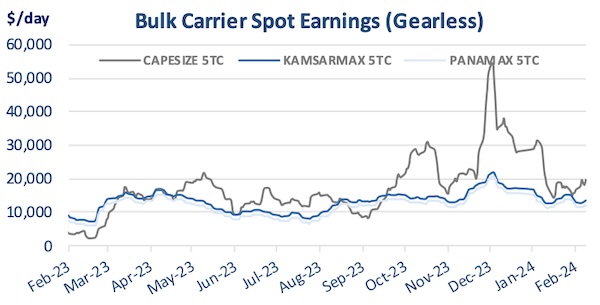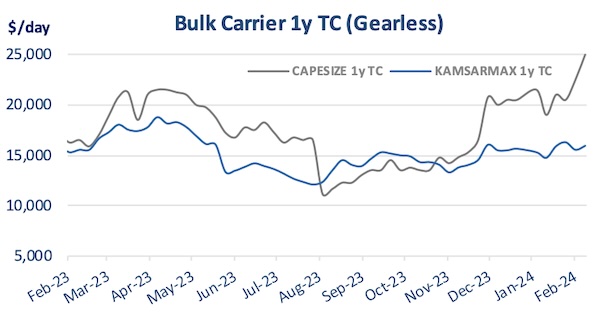
There are a lot of questions currently surrounding the potential growth of the Chinese economy and what a slowdown would mean for the dry bulk industry. In its latest weekly report, shipbroker Xclusiv Shipbrokers said that “China’s recent robust commodity imports raise questions about their sustainability in light of the upcoming holiday. Iron ore imports witnessed a particularly strong start in January, reaching a near-record high of 112.57 million metric tons, just shy of the July 2020 peak of 112.64 million tons. Seaborne thermal coal imports also started 2024 on a positive note, estimated at 27.9 million tons for electricity generation. Though lower than December’s 31.7 million tons, this figure remains significantly higher than January 2023’s 20.85 million tons and reflects a continuing trend of strong coal arrivals. Similarly, LNG imports saw a winter boost, with estimated arrivals in January reaching 7.77 million tons. Both December and January figures surpassed the previous year by 12.1% and 28%, respectively, highlighting a noticeable increase. While these figures signal a promising start to 2024, the looming Lunar New Year holiday introduces uncertainty. Many factories and ports shut down during this period, potentially impacting import activity. Whether the January momentum can be sustained remains to be seen”.

Source: Xclusiv
Meanwhile, “leaving China aside, let’s shift our focus to India and the International Energy Agency’s (IEA) recent predictions. In its report, the IEA forecasts a substantial expansion of India’s role in global oil markets over the next decade, driven by robust economic, population, and demographic growth. This surge is expected to make India the largest source of global oil demand growth.

Slowing growth in developed economies and China opens the door for India to assume this leading position between now and 2030. To meet this anticipated rise in domestic oil demand, Indian oil companies are investing heavily in the refining sector. Over the next seven years, they are expected to add 1 million barrels per day (b/d) of new refinery distillation capacity, surpassing any other country except China”, Xclusiv said.

Source: Xclusiv
The shipbroker added that “the age profile of global fleets have shifted significantly, highlighting contrasting trends between tankers and bulkers. The tanker fleet witnessed modest growth of just 1.7%, adding only 141 new vessels due to the historically low orderbook and subdued freight rates prior to February 2022. This translated to an aging fleet, with vessels aged 0-5 years decreasing by 10%, those between 6-15 years declining by 7%, and those exceeding 15 years surging by 20%. Conversely, the dry bulk fleet experienced substantial growth driven by a steadily rising orderbook, with 488 new vessels joining the fleet (a 3.4% year-over-year increase). Younger bulkers dominated the additions, with the 0-5 year age group expanding by almost 11%, while the 6-15 year group saw a slight reduction. While vessels older than 16 years grew by 12%, their overall share remained smaller compared to the tanker fleet. This divergence highlights the differing dynamics at play in each sector, with tankers facing limited expansion and aging vessels, while dry bulk enjoys robust growth and a younger fleet profile”, Xclusiv concluded.
Nikos Roussanoglou, Hellenic Shipping News Worldwide



